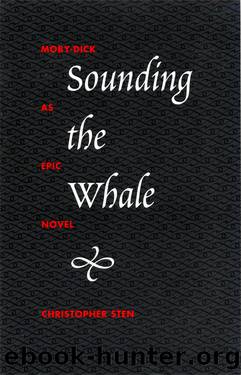Sounding the Whale by Moby-Dick

Author:Moby-Dick
Language: eng
Format: epub
Publisher: The Kent State University Press
IV. DEATH BY WATER
“The Great Heidelberg Tun” is an important threshold chapter, marking the beginning of the questers’ descent into the whale. Having caught, killed, and dragged a sperm whale to the ship and then stripped away the blubber and beheaded it, the crew hoists the head against the Pequod’s side in preparation for the difficult maneuver of breaking into the interior case or “tun.” Earlier, in chapters 74 and 75, Ishmael had imagined himself going inside the mouths of a sperm whale and a right whale while conducting a tour of the two as they hang on opposite sides of the ship. But chapter 77 signifies the first actual venture inside a whale, literally a cutting through the wall in search of buried treasure. When such efforts are successful, the end result is “the Baling of the Case,” or retrieval of the precious “sperm,” from the large reservoir within the whale’s head (339).
In this and the following chapter, “Cistern and Buckets,” where Queequeg rescues Tashtego from the whale’s head after it breaks loose and starts sinking, Melville begins using language that involves a vast conceit whereby the sperm oil stands for the vital “fluid” of the human soul. Repeatedly described as “precious” or “invaluable” and “pure,” the sperm is said to be contained in the “sanctuary,” or “secret inner chamber and sanctum sanctorum,” of the whale. This curiously holy, sexually charged, life-giving substance is Melville’s version of the object of the epic quest in its most essential form, the “unalloyed” oil that requires a “marvellous,” yet sometimes “fatal,” operation to tap it, as Tashtego learns to his horror (339–40, 344). Not all whalemen, of course, succeed even at capturing the sperm whale, let alone at breaking into its tun and retrieving this most valued of prizes. Like the men of the Virgin, described in chapter 81, they may spend their days going from ship to ship begging a little oil, forever dependent on others for the light they need to show them the way.
The whole of part four of Moby-Dick focuses on the whale’s interior. All the world seems rushing to gain entrance there, to search for its riches, to experience its transforming power, to know the beast from inside. Opening with Tashtego’s accidental entombment in the sperm whale’s tun, the fourth section closes with Ishmael’s very deliberate venture inside a whale’s skeleton, described in “A Bower in the Arsacides,” where he has gone to gather measurements for his study of the magnitude of the monster (chapters 102–05). Along the way, Ishmael contemplates the “nut” or brain of the whale, which is buried deep in its head; he discusses the historical likelihood of Jonah’s being swallowed into the whale’s belly; he offers a chapter on “ambergris,” the valuable, waxlike substance found deep in its bowels; and, in still more imaginative variations on this theme, he writes of his own experience of being encircled by a great swirling herd of whales in “The Grand Armada” and then of the ship’s mincer encasing himself within the whale’s foreskin in “The Cassock.
Download
This site does not store any files on its server. We only index and link to content provided by other sites. Please contact the content providers to delete copyright contents if any and email us, we'll remove relevant links or contents immediately.
Sapiens: A Brief History of Humankind by Yuval Noah Harari(14327)
Sapiens by Yuval Noah Harari(5328)
Pale Blue Dot by Carl Sagan(4962)
Homo Deus: A Brief History of Tomorrow by Yuval Noah Harari(4875)
Livewired by David Eagleman(3733)
Origin Story: A Big History of Everything by David Christian(3668)
Brief Answers to the Big Questions by Stephen Hawking(3394)
Inferior by Angela Saini(3296)
Origin Story by David Christian(3170)
Signature in the Cell: DNA and the Evidence for Intelligent Design by Stephen C. Meyer(3103)
The Gene: An Intimate History by Siddhartha Mukherjee(3076)
The Evolution of Beauty by Richard O. Prum(2966)
Aliens by Jim Al-Khalili(2804)
How The Mind Works by Steven Pinker(2784)
A Short History of Nearly Everything by Bryson Bill(2667)
Sex at Dawn: The Prehistoric Origins of Modern Sexuality by Ryan Christopher(2500)
From Bacteria to Bach and Back by Daniel C. Dennett(2464)
Endless Forms Most Beautiful by Sean B. Carroll(2448)
Who We Are and How We Got Here by David Reich(2418)
